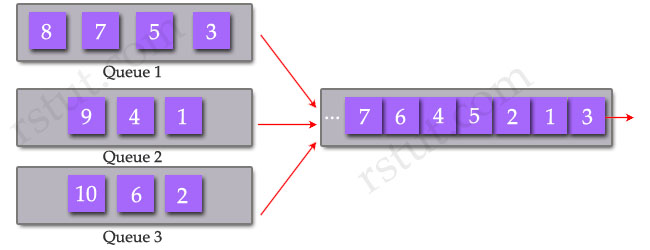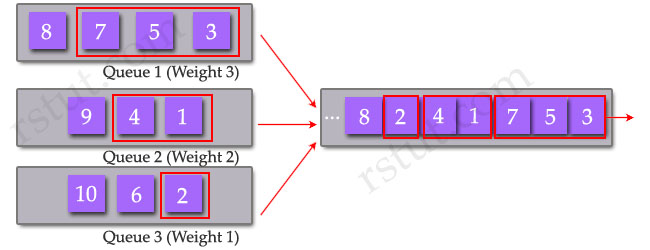Here you will find answers to QoS Questions – Part 2
Question 1
What is an important consideration that should be taken into account when configuring shaped round robin?
A. It enables policing.
B. Strict priority is not supported.
C. WRED must be previously enabled.
D. It enables WRR.
B. Strict priority is not supported.
C. WRED must be previously enabled.
D. It enables WRR.
Answer: B
Explanation
First we need to understand how round robin algorithm works. The round robin uses multiple queues and dispatches one packet from each queue in each round with no prioritization. For example, it dispatches:
+ Dispatch one packet from Queue 1
+ Dispatch one packet from Queue 2
+ Dispatch one packet from Queue 3
+ Repeat from Queue 1

There are three implementations of Round Robin scheduling on the Catalyst 6500 and they include Weighted Round Robin (WRR), Deficit Weighted Round Robin (DWRR) and Shaped Round Robin (SRR).
The Weighted Round Robin allows prioritization, meaning that it assigns a “weight” to each queue and dispatches packets from each queue proportionally to an assigned weight. For example:
+ Dispatch 3 packets from Queue 1 (Weight 3)
+ Dispatch 2 packets from Queue 2 (Weight 2)
+ Dispatch 1 packet from Queue 1 (Weight 1)
+ Repeat from Queue 1 (dispatch 3 next packets)

Unlike Priority Queuing, which always empties the first queue before going to the next queue, this kind of queue prevents starvation of other applications such as if a large download is in progress.
The Weighted Round Robin can be used with Strict Priority by setting its weight to 0. That means packets in the other queues will not be serviced until queue 4 is emptied.
The problem of WRR is the router is allowed to send the entire packet even if the sum of all bytes is more than the threshold and can make other applications starved.
The Deficit Round Robin solves problem of WRR by keeping track of the number of “extra” bytes dispatched in each
round – the “deficit” and then add the “deficit” to the number of bytes dispatched in the next round.
Shaped Round Robin (SRR) is scheduling service for specifying the rate at which packets are dequeued. With SRR there are two modes, shaped and shared. Shaped mode is only available on the egress queues. Shaped egress queues reserve a set of port bandwidth and then send evenly spaced packets as per the reservation. Shared egress queues are also guaranteed a configured share of bandwidth, but do not reserve the bandwidth. That is, in shared mode, if a higher priority queue is empty, instead of the servicer waiting for that reserved bandwidth to expire, the lower priority queue can take the unused bandwidth. Neither shaped SRR nor shared SRR is better than the other. Shared SRR is used to get the maximum efficiency out of a queuing system, because unused time slots can be reused by queues with excess traffic. This is not possible in a standard Weighted Round Robin. Shaped SRR is used to shape a queue or set a hard limit on how much bandwidth a queue can use. When you use shaped SRR, you can shape queues within a port’s overall shaped rate.
(Reference: http://www.cisco.com/en/US/prod/collateral/switches/ps5718/ps7078/prod_qas0900aecd805bacc7.html)
Question 2
What are the advantages of using WRED ? (Select two)
A. offers bounded low latency
B. offers minimal bandwidth guarantees
C. avoids TCP synchronization
D. allows a different drop profile to be manually enabled for each IP precedence or DSCP
B. offers minimal bandwidth guarantees
C. avoids TCP synchronization
D. allows a different drop profile to be manually enabled for each IP precedence or DSCP
Answer: C D
Explanation
Nowadays most routers have packet queues, which allow them to hold packets in their buffers during periods of congestion, rather than discarding them. However, the buffers have limited size and the queue is allowed to fill to its maximum size. If the queue is bigger than the buffer, surely some packets must be discarded; the decision is depended on which algorithm is used. One of the congest management algorithm is Random Early Discard (RED) algorithm whereby random frames are refused admission to the queue once a threshold has been exceeded. Cisco routers do not support RED but it supports the better one: WRED.
Weighted RED (WRED) is a derivative of RED whereby the frames priority values are inspected to determine which frames will be dropped. When the buffers reach set thresholds, then (typically) lower priority frames are dropped allowing the higher priority frames to enter the queue.
The difference between RED and WRED is that WRED can selectively discard lower-priority traffic when the interface begins to get congested. In WRED, a queue may have several different queue thresholds. By default, WRED uses a different RED profile for each weight. Each queue threshold is associated to a particular IP precedence or DSCP. For example, a queue may have lower thresholds for lower priority packet so that it drops less important packets more aggressively than important packets during periods of congestion -> D is correct.
Now let’s talk about global synchronization!
TCP has automatic recovery from dropped packets (usually when the network is congested). The sender reduces its sending rate for a certain amount of time, and then tries to find out if the network is no longer congested by increasing the rate again. This is known as the slow-start algorithm.
Almost all the senders will use the same time delay before increasing their rates. When these delays expire, at the same time, all the senders will send additional packets, the router queue will again overflow and packets will be dropped, the senders will all back off for a fixed delay… This pattern of each sender decreasing and increasing transmission rates at the same time as other senders is referred to as “global synchronization” or “TCP synchronization” and leads to inefficient use of bandwidth, due to the large numbers of dropped packets, which must be retransmitted.
WRED reduces the chances of tail drop (used by TCP) by selectively dropping packets when the output interface begins to show signs of congestion. By dropping some packets early rather than waiting until the queue is full, WRED avoids dropping large numbers of packets at once and minimizes the chances of global synchronization. Thus, WRED allows the transmission line to be used fully at all times -> C is correct.
Note: Tail drop is the simplest technique to limit queue size. When the queue is full, it simply discards any new packets until there is space in the queue again.
Question 3
WRED is a congestion avoidance mechanism. In what situation is WRED most useful?
A. most traffic is TCP-based
B. very high bandwidth interfaces such as Gigabit Ethernet
C. an equal distribution of TCP and UDP traffic
D. a mix of TCP.UDP, and non-IP traffic
B. very high bandwidth interfaces such as Gigabit Ethernet
C. an equal distribution of TCP and UDP traffic
D. a mix of TCP.UDP, and non-IP traffic
Answer: A
Question 4
Refer to the exhibit. Based on this configuration, what type of marker is achieved?
policy-map QoSPolicer
class PolicedTraffic
police cir 512000 pir 1024000
conform-action transmit
exceed-action set-dscp-transmit csl
violate-action drop
A. Single-rate, two-color marker
B. Three-rate, two-color marker
C. Two-rate, three-color marker
D. Single-rate, three-color marker
B. Three-rate, two-color marker
C. Two-rate, three-color marker
D. Single-rate, three-color marker
Answer: C
Question 5
Refer to the exhibit. Based on the configuration shown, which queuing mechanism has been configured on interface serial 1/0?
RouterC#show policy-map interface serial 1/0
Serial1/0
Service-policy output: BW-Assignment
Class-map: VoIP (match-all)
0 packets, 0 bytes
5 minute offered rate 0 bps, drop rate 0 bps
Match: protocol rtp audio
Queueing
Output Queue: Conversation 265
Bandwidth 50 (%)
Bandwidth 772 (kbps) Max Threshold 64 (packets)
(pkts matched/bytes matched) 0/0
(depth/total drops/no-buffer drops) 0/0/0
Class-map: FTP-Data (match-all)
0 packets, 0 bytes
5 minute offered rate 0 bps, drop rate 0 bps
Match: access-group name FTP-Data
Queueing
Output Queue: Conversation 266
Bandwidth 10 (%)
Bandwidth 154 (kbps) Max Threshold 64 (packets)
(pkts matched/bytes matched) 0/0
(depth/total drops/no-buffer drops) 0/0/0
Class-map: class-default (match-any)
4 packets, 954 bytes
5 minute offered rate 0 bps, drop rate 0 bps
Match: any
RouterC#
A. PQ
B. CQ
C. WFQ
D. LLQ
E. CBWFQ
B. CQ
C. WFQ
D. LLQ
E. CBWFQ
Answer: E
Sign up here with your email

ConversionConversion EmoticonEmoticon